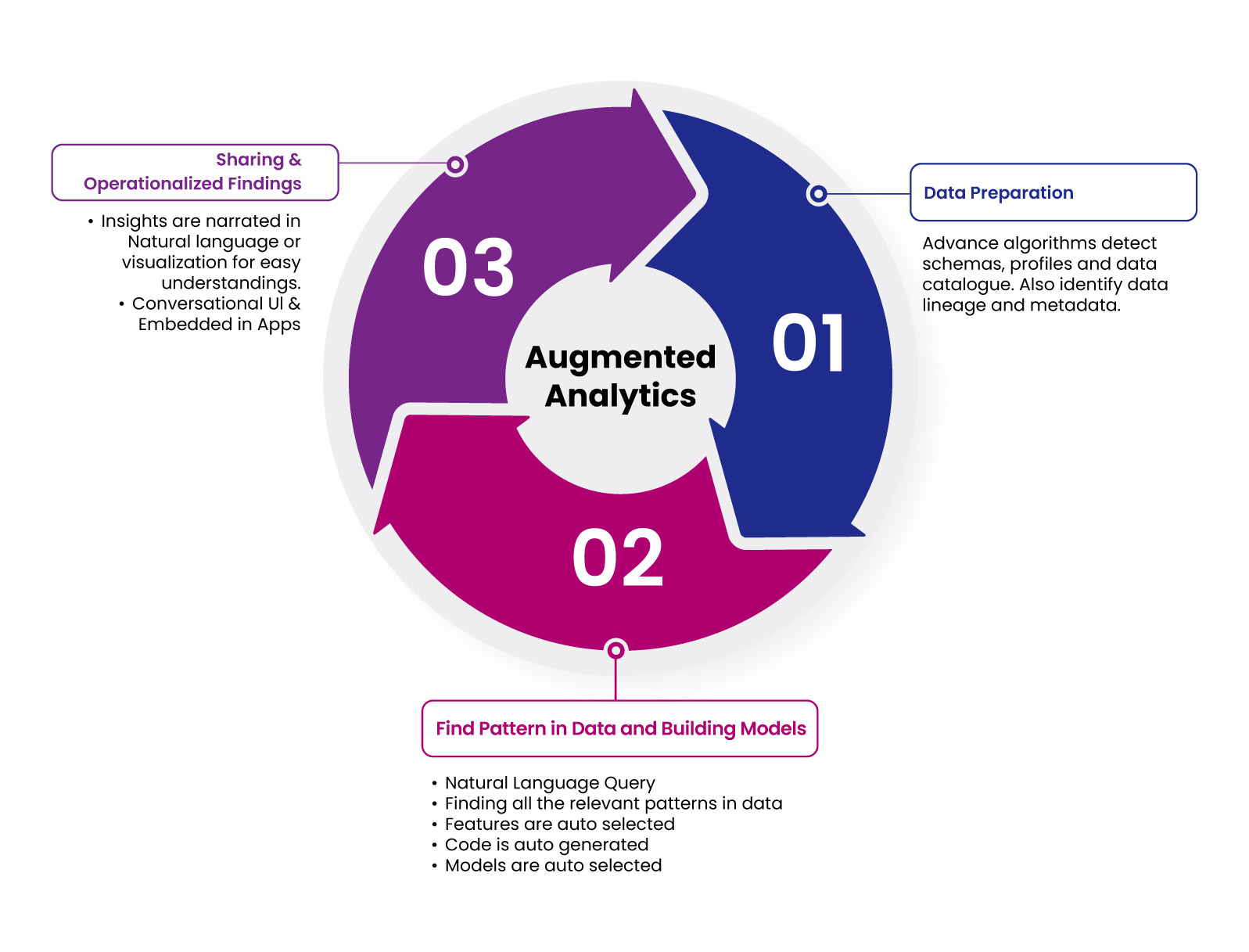Analytics has come of age, now augmented with AI
April 21, 2025
For the longest time, businesses have been told about the importance of data collection, and the experts who emphasized this weren’t wrong. Fast forward to today, and reliance on data has grown exponentially, and rightly so. With each enterprise sitting on a potential goldmine of data from user behavior, sales, marketing, and operations, leaders are now strategizing to unlock as much value as they can from these internal resources. However, the sheer volume of data available to organizations makes accurate interpretation a real challenge. As the volume and the complexity of datasets are increasing, traditional BI tools might not handle them efficiently. Today, quick and unbiased data analysis is necessary to meet the business objectives.
The job of organizing, processing, and drawing insights primarily depends on data engineers and data scientists. These highly skilled roles are responsible for data ingestion, cleansing and transformation, and developing advanced AI/ML algorithms to gather relevant data. Not surprisingly, the shortage of these technical roles is another challenge. But augmented analytics systems promise to ease this bottleneck by delivering quick and accurate insights by minimising the needs of full-time data engineers and scientists.
State of AI in KSA
Saudi Arabia reached a significant milestone in the digital realm by introducing a nationwide AI policy. The Saudi Data and Artificial Intelligence Authority (SDAIA) launched this policy to steer the country’s transformation into a data-driven economy. As part of its Vision 2030, the country aims to develop sustainable cities and optimize resource utilization across key sectors. This vision has prompted the government to recognize the critical role of AI and automation in boosting national efficiency. Additionally, Saudi Arabia is planning educational reforms to align with AI and digital skills, further driving the development of AI. This progress will enhance the use of AI for data analysis, creating growth opportunities for the augmented analytics market.
A quick run-through of augmented analytics
When we refer to augmented analytics, it is a process where data is automatically ingested from raw data sources, cleansed in an unbiased manner, and communicated to business users. The entire process works independently. In other words, we can say augmented analytics uses AI/ML to automate data preparation, insights discovery, and information exchange.
In other words, we can say augmented analytics uses AI/ML and augmented intelligence to automate data preparation, insights discovery, and information exchange.
The term augmented analytics was coined by Gartner in 2017 in their annual "hype cycle" report, where it was hailed as "the future of data analytics." It is now widely regarded as the future of business intelligence and data analytics.
The evolution of analytics has come a long
- Traditional analytics
Analytics were primarily driven by IT, with limited user autonomy and a focus on large-scale reporting.
- Self-service analytics
Business users gained more autonomy, utilizing user-friendly interfaces to generate insights independently.
- Augmented analytics
AI and machine learning revolutionized analytics, empowering users with deep, actionable insights through automated tools and guided processes.
What makes augmented analytics so valuable?
Since augmented analytics is a modern-day approach for yielding maximum business benefits, they can bring the top business features like:
- Automated data detection
One of the most demanding features of augmented analytics is automatic data detection functions. It collects data based on specific attributes like schemas, profiles, and geographic and personal information fetched from disparate sources like text documents and PDFs.
- Statistical operational algorithms
Pre-built algorithms are helpful in forecasting. Statistical operational algorithms eliminate the need for extensive calculations and simplify the need for specialized coding. Statistical operational algorithms can also be tailored according to business needs.
- Advanced recommendations
Another feature of augmented analytics is AI/ML-driven recommendations system. It trims down the data lifecycle, including data preparation, analysis, and reporting. Moreover, AI/ML-driven recommendations can be generated for diverse users based on their specific requirements.
Leveraging businesses with augmented analytics
Machine learning makes it possible to pool the most compelling business insights to answer business curiosity. With augmented analytics, business users will get actionable insights, enhanced productivity, and can elevate their skills and better decision-making.
- Data Ingestion Automation
Augmented Analytical tools are trained to gather, refine, and process the data automatically. The process still requires a data scientist to aid in the process of developing machine learning algorithms for cleaning and structuring data. But once done, the future processing is quicker, which leads to accelerated data analysis.
- Lower cost of ownership
Technically, having people on-site pouring data in, cleansing it, and reporting can cost more. The use of AI & ML eliminates the risk of data redundancy due to less human dependency. The entire process is automated, and quicker, with a lower cost of ownership.
- Quicker business value generation
Automatic data processing ultimately results in higher business value delivery and productivity. Augmented analytic systems streamline the entire data process by leveraging machine learning algorithms to perform repetitive tasks and visualizations, helping organizations to become more agile and responsive.
- Democratization of analytics
Augmented and SaaS analytics platforms provide powerful AI/ML-generated data results available to everyone within organizations. Modern SaaS platforms are more accurate and inexpensive compared to in-house data analysis management teams.
Use cases for augmented analytics
According to Fortune Business Insights, the global augmented analytics market was valued at USD 11.66 billion in 2024. It is projected to grow to USD 15.26 billion in 2025 and reach USD 87.03 billion by 2032, exhibiting a CAGR of 28.2% during the forecast period.
Augmented analytics have the power to revolutionize business processes – but what does this look like in the real world? Here are a few examples of use cases for augmented analytics:
Augmented analytics in banking and finance
Financial institutions like banks, mortgages, and insurance firms are faced with different challenges with the fintech industry going through a post-pandemic transformation. As the industry is actively looking for innovative solutions, stringent government regulations make things more competitive. Here augmented analytics can play a vital role in generating authentic data more quickly.
Augmented analytics in telco
Augmented analytics can help telecom operators better understand shifting customer needs by analyzing large data sets, detecting issues and predicting customer behavior. It also aids in fraud detection, churn prevention, and improving service accuracy and speed by automating data preparation and analysis. By predicting network anomalies and identifying trends, augmented analytics empowers telecom providers to react quickly to market changes and enhance customer satisfaction.
Augmented analytics in healthcare
The healthcare industry is always in need of the latest tools and technologies. A massive amount of data is generated during research, clinical trials, patient records, and experiments. AI/ML-embedded analytics can reduce their research time while ensuring more accurate results in real time for seamless medical practice.
Augmented analytics in the public sector
The public sector is leveraging augmented analytics to enhance public services, optimize resource allocation, and drive smarter policy decisions. By analyzing data across sectors like transportation, healthcare, and public safety, agencies can identify patterns early and tackle challenges proactively.
This technology also enables predictive analytics, allowing governments to anticipate future needs such as emergency responses or infrastructure improvements. With these insights, policymakers can streamline operations, improve resource management, and strategically address the evolving needs of their communities.
Take charge of your business with Systems Arabia
In a business landscape defined by data, the choice of an augmented analytics solution could make the difference between success or failure. Today, the infusion of big data analytics in business operations is critical for revealing actionable insights, eliminating human bias, accurate forecasting, and generating successful recommendations.
The innovative capabilities of augmented analytics are expected to demonstrate various benefits across diverse market verticals. AI/ML embedded enablers promise to transform the data landscape by streamlining business strategies. Augmented analytics is undoubtedly an opportunity to uplift existing and future businesses at scale.
At Systems Arabia, we specialize in helping companies in KSA and beyond seamlessly adopt augmented analytics into their business operations. We leverage state-of-the-art machine learning (ML) algorithms and natural language (NLP) processing capabilities to make data analytics more accessible and actionable for businesses.
Head over to our data analytics page or connect with us here to learn more.
Quick Link
You may like
How can we help you?
Are you ready to push boundaries and explore new frontiers of innovation?


